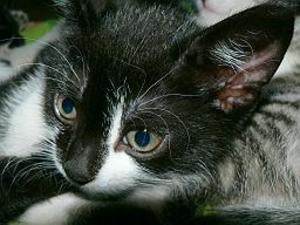Unlike dogs who communicate with humans by peering into the master’s eyes and then darting off towards whatever it is they want or need, cats employ a wide range of vocalizations, many of which are reserved for their communication with humans. The “meow” for instance, is used only in relation to a cat’s newborn kittens( or when she is training those kittens), and communicating with humans. Cats do not meow to communicate with each other.
Cats use over 100 different sounds to communicate (dogs reportedly can make only 10 distinct sounds). These range form a variety of “meows”, purrs, and other sounds. Over time, you will learn what your cat “means” by each of these unique sounds. By taking the time to really listen to your cat and responding verbally to him, you and your cat will soon learn to communicate with each other.
All Meows are not Created Equal
Their repertoire of sounds serves them well in a human relationship. If you have ever shut your cat in the bathroom, you no doubt recognize the tiny meow that pleads, “Let me out. Let me out.” If you have ever ignored this plea for assistance, you no doubt heard the vocal meow of a cat that has been ignored. If long ignored, you may hear the loud “ME-OOOW” as he cries in desperation for your attention.
The Friendly “prrrt”: A Greeting
But, as any cat owner can attest, these are not the only sounds your cat makes in an attempt to communicate with you. The friendly “prrrt” that he greets you with in the morning, is just that. A greeting. Your cat may actually be saying “good morning“. It is often uttered throughout the day. As your cat leaps onto your lap, he often accompanies this with a little “prrrt“. It is his way of of saying, “Hi there, mind if I sit for a spell?” He may also express a similar sound when he is mildly surprised, by you. He’s simply saying “Oops. I didn’t know you were there! This is pleasant surprise.”
Purring May Have Healing Effects
Although there is some confusion over exactly why cats purr, there is consensus that cats purr when they are happy and contented. Some cats have been known to purr when they are very ill, or even near death, which has caused some speculation on the effects of purring on healing. In fact, some preliminary research has shown that a cat’s purr may actually have healing effects on humans. It is known that stroking a cat can reduce stress and in turn reduce blood pressure in humans.
Talking to Your Cat will Increase His Vocabulary
Although there are many sounds that cats employ to communicate with you, not all cats will exhibit all the sounds. Cats, it seems, are very much like humans in this respect. Some are “talkers” and some are not. Research has shown that the more you talk to and respond to your cats vocalizations, the more he will “talk” to you. So the next time your cat voices a concern or a need, don’t merely fill the need in silence. Talk to him. He has, after all, developed quite a repertoire of “meows” designed simply for his communication with you. The least you can do is answer him.
Sources:
http://www.messybeast.com/cat_talk.htm
www.21cats.org
www.petplace.com






